Garcia GT54 Le Trawler, a Furuno winner
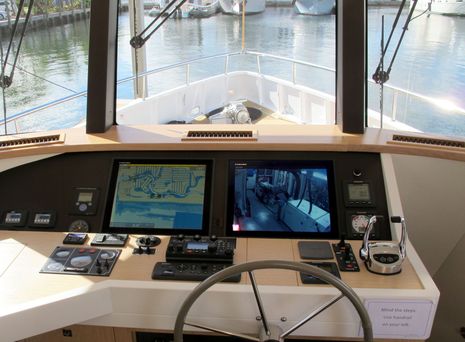
I did get to tour a couple of yachts during my Trawler Fest engagement and the one that got my attention was the Garcia GT54 hull #1, which was built in France and motored to the U.S. on her own bottom...during hurricane season! "Le Trawler" is both stylish and practical in numerous ways, and it's also a good example of a full-on Furuno NavNet 3D system...
As you can see in the diagram below the GT54's electronics are virtually 100% Furuno, including FI-50 instrumentation -- Panbo data tested here, and in direct sun here -- and a NavPilot 711 system which shares at least compass info over NMEA 2000 but keeps a direct private connection between control heads and course computer. There's also a FM4721RS VHF with two command mics which I can only find at Furuno France, again illustrating -- like PC Radar -- how independent the regional distributors are. I'm a little surprised that they didn't use RD-33 instrument displays, which I'm still testing and liking, because their color screens are so informative and also because an RD33 could have supplied 0183 data to the VHF, instead of using a "Convertisseur".
The heart of the system, though, is the NavNet 3D MFDBB in the wheelhouse driving those two 19-inch screens seen above. Note that the IP cameras are coming through the MFDBB, I'm pretty sure, and thus can be displayed on either screen or on the fly bridge MFD12 (I believe the diagram is missing the cable between the two Ethernet hubs). Also shared across Ethernet are the
DRS4A radar (a stellar performer in my experience) and the DFF1 fish finder, as well as a PC running MaxSea TimeZero Explorer...
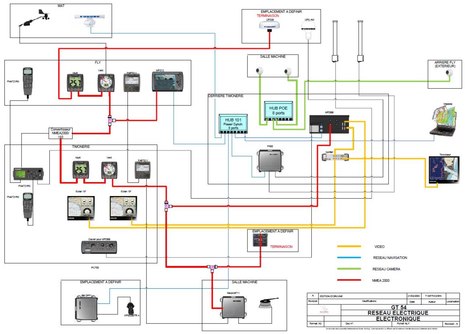
It's interesting that while the NavNet TZtouch Black Box (TZTBB) announced last October (PDF here) would probably be sexier, it can not drive two independent displays (just mirrored displays). Apparently that's a limitation of touch screens. On the other hand, I recently learned that the new TZT V2 software supports a dual networking scheme that sounds powerful. On the GT 54 and other NN3D systems, the Ethernet system is designed to be Furuno-only, though the PC running MaxSea can go online via WiFi to get weather data etc. Here's what a Furuno developer told about the new scheme:
I think we found the solution to the concern "I want to keep my network private" (that we have as a manufacturer) while allowing third party "stuff" (FLIR Camera, Internet Connection, routers, etc...) to be connected on the same physical network as NavNet. Basically we use two networks on the same physical layer. The NavNet sensor (DRS, Sounder, etc..) use a Class-B network (172.31.x.x) while third party use a class-C network (192.168.252.x). Only the TZtouch (by having two IP address) can access both networks and access both NavNet and third party (FLIR and/or Internet for example). The third party sensors and NavNet sensors, while on the same physical network are virtually isolated because on two different network. This means that Internet traffic would not impact the DRS or sounder or (the other way) the Radar Traffic would not impact the FLIR camera.
To my knowledge no other MFD manufacturer has figured out how to mix critical nav networks with other "stuff" and I think it will become important. One example I can think of is the big TZT and Maretron install I got to see at Lyman Morse last summer; that yacht's many IP cameras could not be shared between the Furuno and Maretron N2KView systems, though both support them. Now apparently the boat can get that flexibility if the owner wants. But I digress; back to Le Trawler...
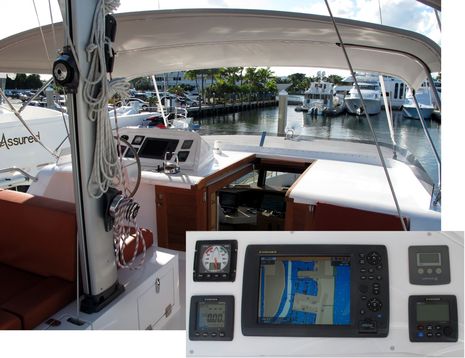
Note the fairly serious rigging seen on the fly bridge. Garcia's heritage is semi-custom aluminum sailboats and it shows on the GT 54. Hull #1 not only has a 116 square foot steadying sail but also a 370 square foot furling gennaker as well as almost 9,000 pounds of resin-encapsulated steel ballast in her 5.5-foot draft keel. Le Trawler is not meant to be a motorsailor but she is meant to be comfortable in heavy going without stabilizers, which makes a lot of sense to me. I get the idea of slow trawling as a gentle, efficient way to cruise but it bothers me that many displacement-speed trawlers feel the need for the complication and expense of active stabilization.
At any rate, the GT 54 hull #1 seems to have proven the concept. Not only did she cross the Atlantic at 8 knots but she did indeed tangle with at least the edge of a hurricane, and they had the video playing on board at Trawler Fest. I'll link to it as soon as it gets online because I thought it neat how this boat held herself like a sailboat in some big bumps. And note below how Garcia used a Volvo Penta D2-75 saildrive for a get-home (at 5 knots) wing engine, which also seems pretty clever as saildrives are designed for minimum drag when not in use...
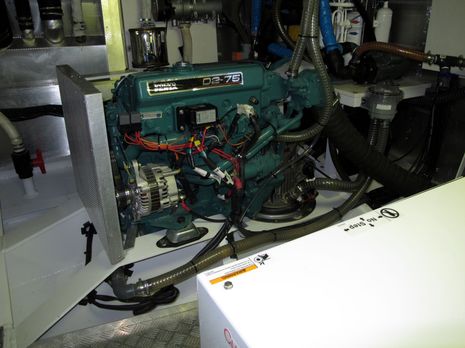
As you'll see at the Garcia site, Le Trawler's interior is wonderfully light and open. But one completely non-electronics detail that impressed me is how the Corian counter tops are routed out to create an elegant sort of fiddling. If you click on the image below you can also see the full sail plan (aside from the steadying force, they do report getting an extra half knot from the gennaker). There's also a YachtForums GT54 article which includes construction photos and which was written by one of the current brokers, Judy Waldman...
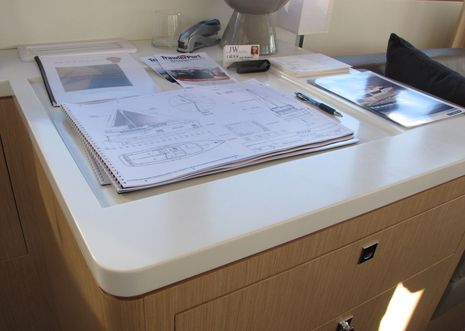
Yes, Le Trawler #1 is for sale and you can see it next week in Miami. The photo below is very wide angle, but you can get a sense of the style, and the great sight lines from either helm. I also got aboard Rest Assured, the Nordhavn 68 (also for sale), and found two NavNet MFDBB's, four 21-inch Furuno displays, and much more in her wheelhouse. It's a small sample but Furuno seems to be doing very well in the big trawler market. However, they are about to see some new competition, about which I can say no more until next Thursday ;-)
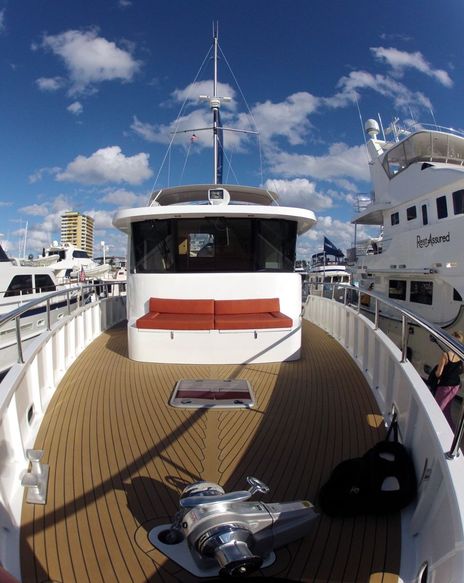

 Share
Share
Le Trawler was fitted out last year in the same yard at the same time as our sailing yacht - at the Allures factory in Cherbourg, Northern France. They specialise in aluminium sailing yachts with lifting centreboard designed and fitted out for long distance blue water sailing.
The guys at the factory were incredibly proud of the finish and level of equipment, and it was a big project for them. It is nice to see it is receiving great reviews. I recall the press couldn't believe the standard of the rolled aluminium hull without chines - they thought it was GRP.
The boat headed across last year in mid September in a two week window between boat shows, and were pretty oblivious to the hurricanes of that time!
(We're heading across later this year, so will be working our way up the east coast next spring headed for the Northwest passage later that season. Hopefully catch up with a few Panbo-ers then)